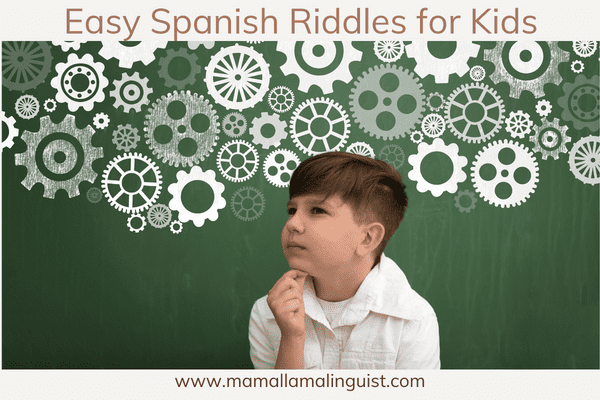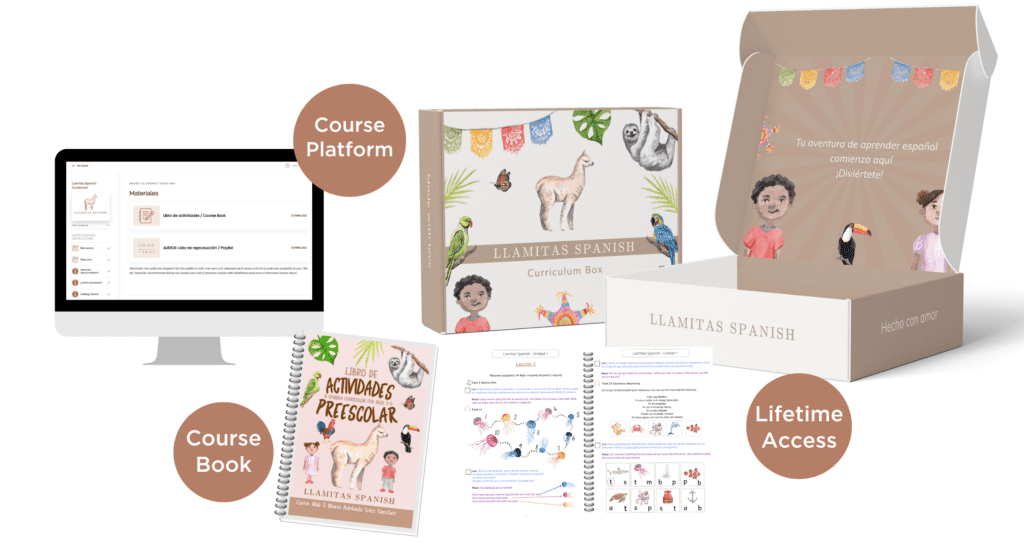In this post: Introduce your kids to riddles in Spanish as a great way to get them thinking while having fun and learning.
The holidays are over which means it’s time to get back to our regularly scheduled programs. After all the festivities, it may be difficult to resume regular Spanish lessons with your kids. A great way to get them back on track is to start with something fun, so in today’s post we’re talking all about adivinanzas (riddles).

This post contains affiliate links. As an Amazon associate I earn from qualifying purchases.
If one of your goals or resolutions this year is to teach your kids even more Spanish, be sure to check out our round-up of the best FREE Spanish resources that can support your child’s language learning at home.
Now, let’s get into today’s blog!
Related post: Raising Bilingual Kids in the USA
Table of Contents
What are adivinanzas?
Adivinanzas is the Spanish word for riddles and comes from the verb adivinar which means ‘to guess’.
Rightfully so as riddles can be described as phrases, statements or questions that pose a puzzle or have a purposely ambiguous meaning for others to solve.
Similar to trabalenguas (tongue twisters), they’re fun and catchy and kids love them. Many riddles have even become classics that shaped our childhood as they continue to be passed down from generation to generation.
At the same time, I think as adults we can agree that they’re just as fun as we age and encounter those that are increasingly difficult and thought-provoking. A riddle is the perfect icebreaker, conversation starter or quick activity to pass time.
Enjoy even more moments of family time, laughter and learning in our Spanish Freebie Library where you’d find a PDF of these ‘adivinanzas para niños’ as well as additional activities and games such as trabalenguas, lotería, matching games and more!
15 Simple Spanish Riddles for Kids
Some riddles are more difficult than others and will keep you guessing. Add to that the Spanish element and you’ve certainly got yourself a challenge. That’s all part of the fun, ¿verdad? (right?)
So now it’s time to grab your thinking caps – maybe a dictionary as well – and let’s get into some Spanish riddles you can try with your kids.
We’ll be sure to list the answers below to avoid spoiling all the fun.
- Vuelo de noche, duermo de día y nunca verás plumas en el ala mía.
I fly at night, I sleep during the day and you’d never see feathers on my wings.
- Blanco es, la gallina lo pone, con aceite se fríe y con pan se come.
It’s white and comes from a hen, you fry it with oil and eat it with bread.
- Soy más de uno sin llegar al tres, y llego a cuatro cuando dos me des.
I’m greater than 1 but not larger than 3 and I get to 4 when you add 2 more.
- ¿Qué te da el poder y la fuerza para caminar a través de una pared?
What gives you the power and strength to walk through a wall?
- Fríos, muy fríos estamos y con nuestros sabores a los niños animamos.
Cold, we’re very cold and we cheer kids up with our flavors.
- Tengo capa sobre capa. Si me las quitan, de llorar nadie se escapa.
I have layer upon layer. If you take them off, you can’t help but cry.
- Te sirven para escribir, dibujar, señalar y sentir.
They’re useful for writing, drawing, pointing, and feeling.
- ¿Qué es algo que siempre cae, y nunca se rompe?
What’s something that always falls but never breaks?
- Si lo tienes, quieres compartirlo. Si lo compartes, ya no lo tienes. ¿Qué es?
If you have it, you want to share it. If you share it, you no longer have it. What is it?
- ¿En dónde hay ríos pero no agua, hay ciudades pero no edificios, hay bosque pero no árboles?
Where can you find rivers without water, cities without buildings and forests without trees?
- Sólo una vez al año tú celebras ese día, y conmemoras la fecha en que llegaste a la vida.
You celebrate this day once a year and we remember the date on which you were born.
- Se come con cuchara y nunca con tenedor, la tomamos en invierno y entramos pronto en calor.
You eat it with a spoon and never a fork, we have it in winter and it makes you feel warm.
- Tiene cuello, pero no cabeza. ¿Sabes qué es?
It has a neck but no head. Do you know what it is?
- Sin ella en la mano ni entras ni sales, ni vas a la calle.
Without one you can’t enter or leave nor can you go in the street.
- Cuatro patas tiene y no puede andar. También cabecera sin saber hablar.
I have 4 legs and can’t walk. I also have a head but can’t talk.
Answers:
- el murciélago – bat
- el huevo – egg
- Dos – two
- una puerta – a door
- los helados – ice cream
- una cebolla – an onion
- los dedos – fingers
- una cascada – a waterfall
- un secreto – a secret
- un mapa – a map
- tu cumpleaños – your birthday
- la sopa – soup
- una botella – a bottle
- la llave – the key
- una cama – a bed
Spanish Riddle Books for Kids
If you just can’t get enough of these fun riddles, check out the following books that you can easily order on Amazon:
- El adivinario/Book of Riddles: This picture book is beautifully illustrated and has 27 riddles, one for each letter of the Spanish alphabet.
- 1 Adivinanza por día/1 Riddle a Day: Keep the good times going with these clever and fun riddles, 1 for each day of the year. A riddle lover’s dream and the perfect book to enjoy as a family.
Llamitas Spanish Homeschool Curriculum
Remember those resources we mentioned earlier? If you’re ready to take the plunge and teach your kids Spanish at home but want guidance, our Llamitas Spanish Curriculum is just what you need.

Our full-year curriculum includes open-and-go thematic units with essential lessons for the early years fundamentals like phonics, math and literacy, plus games and music!
Related Posts:
Trabalenguas: Spanish Tongue Twisters



